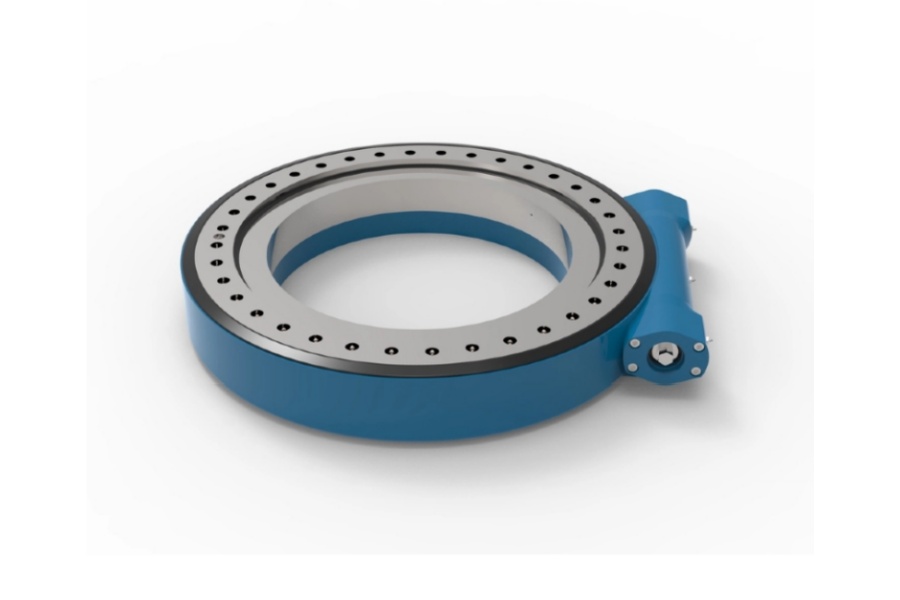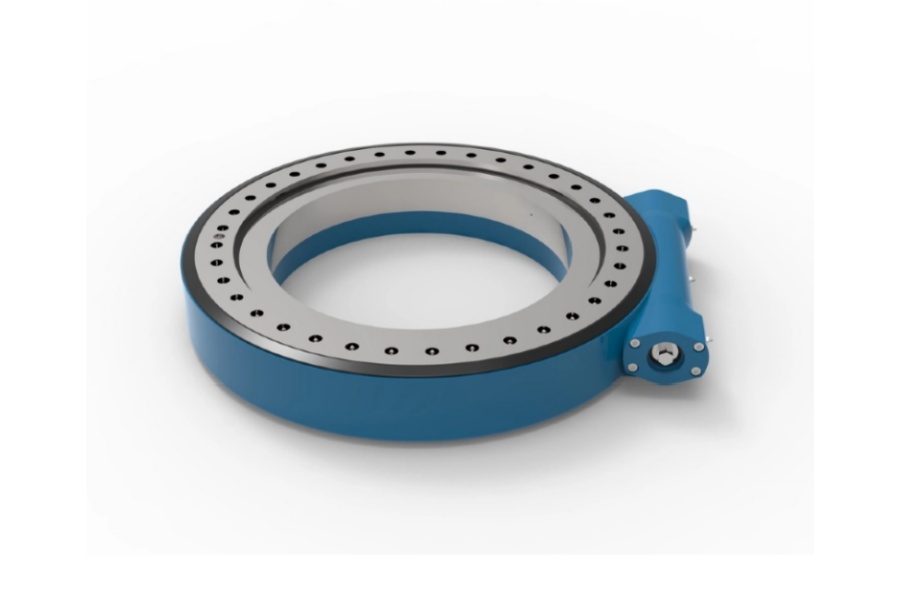
How to Choose Between External and Internal Gear Slew Drives
What is a Slew Drive
A Slew Drive is an integrated mechanical power transmission system that combines a slewing ring bearing with a worm gear mechanism to facilitate controlled rotational movement while supporting substantial combined axial, radial, and moment loads. This engineered assembly efficiently converts input torque from electric, hydraulic, or pneumatic motors into high-torque rotational output through either external or internal gear arrangements. The fundamental design consists of a precision worm shaft that engages with either an externally mounted gear ring or an internally cut gear configuration, both options providing reliable motion control and positioning capabilities. The selection between external and internal gear designs represents a crucial engineering decision that significantly impacts the drive's structural performance, operational efficiency, maintenance requirements, and overall suitability for specific application environments and performance expectations.

Selection Between External and Internal Gear Designs
The decision between external and internal gear configurations requires careful consideration of multiple technical factors and application requirements. Engineers must evaluate specific performance parameters, operational conditions, and economic considerations to determine the optimal gear configuration for their particular application. External gear designs typically feature teeth cut on the outer circumference of the gear ring with the worm screw positioned outside the gear diameter, while internal gear configurations incorporate teeth cut on the inner diameter with the worm positioned inside the gear circumference. Each configuration offers distinct advantages and limitations that must be weighed against application-specific requirements.
Transmission Efficiency and Structural Considerations
External gear slew drives generally exhibit moderately lower transmission efficiency compared to internal gear designs due to increased friction losses and potentially higher mesh friction characteristics. The structural configuration of external gears typically results in somewhat larger overall dimensions and less compact packaging compared to equivalent internal gear units. However, external gear designs benefit from significantly simpler manufacturing processes and more straightforward quality verification procedures, leading to reduced production costs and potentially shorter lead times. The design simplicity of external gears also facilitates easier maintenance access and component replacement when necessary. Internal gear configurations demonstrate superior transmission efficiency through optimized load distribution and reduced friction characteristics in the gear mesh. The compact nature of internal gear arrangements enables more space-efficient designs with reduced envelope dimensions, making them particularly valuable in applications with severe space constraints. The manufacturing process for internal gears requires more sophisticated machining equipment and specialized expertise, resulting in higher production costs but potentially better performance characteristics.
Application Requirements and Load Capacity
External gear slew drives excel in applications requiring robust performance under heavy loads and challenging operating conditions. These configurations typically demonstrate exceptional durability in low-to-moderate speed applications involving substantial shock loads and variable operating conditions. The accessible nature of external gear teeth facilitates easier inspection and maintenance procedures, making them suitable for applications where regular maintenance access is available and operational downtime must be minimized. External gear designs generally accommodate higher contamination tolerance compared to internal configurations, though proper sealing remains essential for long-term reliability. Internal gear slew drives deliver superior performance in high-precision applications requiring smooth operation and precise positioning capabilities. These configurations typically provide enhanced moment load capacity and improved stiffness characteristics due to their supported gear structure and optimized load distribution. The protected nature of internal gear teeth offers inherent contamination resistance, though proper sealing remains critical for maintaining performance in demanding environments. Internal gear designs generally demonstrate better suitability for high-speed applications and continuous operation scenarios where consistent performance and reliability are paramount.
Space Constraints and Installation Considerations
External gear configurations typically require more generous installation space due to their larger overall dimensions and external worm positioning. The mounting arrangements for external gear drives often involve simpler interface requirements and more straightforward installation procedures compared to internal gear alternatives. These designs generally offer greater flexibility in terms of maintenance access and component replacement capabilities, though regular maintenance may be required more frequently depending on operating conditions. Internal gear designs provide significant advantages in space-constrained applications where compact dimensions and efficient space utilization are critical design considerations. The integrated nature of internal gear configurations enables more streamlined installation procedures and potentially reduced structural requirements for supporting equipment. However, internal gear designs may present challenges in terms of maintenance access and component replacement, potentially requiring more extensive disassembly for inspection and service procedures.
Noise and Vibration Characteristics
External gear slew drives typically operate with moderately lower noise levels and reduced vibration characteristics compared to internal gear configurations under similar operating conditions. The gear mesh dynamics of external designs generally produce smoother engagement characteristics with potentially reduced vibration transmission to supporting structures. These characteristics make external gear designs particularly suitable for applications where noise reduction and minimal vibration are important operational considerations. Internal gear configurations may generate slightly higher operating noise levels due to their compact design and different mesh dynamics, though modern manufacturing techniques and precision engineering can significantly mitigate these effects. The vibration characteristics of internal gear drives have been substantially improved through advanced design methodologies and manufacturing technologies, making them suitable for most industrial applications where some operational noise is acceptable.
Environmental and Operational Factors
External gear designs demonstrate generally better tolerance to environmental contaminants due to their more accessible configuration and potentially more effective contamination removal capabilities. These designs typically accommodate wider temperature ranges and more variable operating conditions without significant performance degradation, though proper sealing remains essential. The lubrication requirements for external gear configurations may involve more frequent maintenance intervals but generally simpler lubrication procedures compared to internal designs. Internal gear configurations offer superior protection against environmental factors due to their enclosed design and inherent contamination shielding characteristics. These designs typically maintain more consistent performance in clean operating environments but may require more sophisticated sealing systems in contaminated conditions. The lubrication systems for internal gear drives often feature longer service intervals but potentially more complex maintenance procedures when lubrication service is required.
Key Characteristics of Slew Drives
Slew drives possess distinctive characteristics that make them valuable across numerous industrial applications. Their high torque density enables compact design solutions capable of delivering substantial rotational force from relatively small package dimensions. The integrated design philosophy combines multiple functional elements including bearing support, gear reduction, and mounting structure into a single sealed unit that reduces assembly complexity while improving overall system reliability. Precision positioning capability varies among different quality tiers, with high-performance units offering excellent positional accuracy and repeatability through precisely manufactured gear components. The inherent self-locking capability of the worm gear design provides built-in load holding without requiring additional braking systems, enhancing safety while simplifying control requirements. Robust construction enables reliable operation in demanding industrial environments, with various sealing options available for both external and internal gear configurations to suit different environmental challenges. Flexible configuration possibilities include various mounting orientations, drive motor interfaces, and feedback system integrations that facilitate adaptation to specific application requirements. The structural stiffness of properly manufactured units ensures minimal deflection under load, maintaining precision even when handling substantial off-center loads in either gear configuration.
Broader Applications of Slew Drives
Slew drives serve critical functions across multiple industries with specific gear configuration preferences based on application requirements. The renewable energy sector employs these drives in solar tracking systems where both external and internal gear designs find application based on specific structural and environmental considerations. Construction equipment relies on slew drives for excavator upper structure rotation, crane boom positioning, and concrete pump operation where gear selection depends on load characteristics and space constraints. Wind energy applications utilize these components in yaw and pitch control systems where both configurations serve based on specific design philosophies and maintenance requirements. The aerospace and defense sectors incorporate precision slew drives in radar antenna positioning and weapon systems where gear configuration selection depends on precision requirements and environmental factors. Marine and offshore applications include deck crane rotation and equipment handling systems where corrosion resistance and sealing effectiveness often influence gear design selection. Medical equipment manufacturers use specially engineered slew drives in imaging systems and patient positioning equipment where smooth operation and reliability determine configuration preferences. Industrial automation systems incorporate these drives in robotic positioning and material handling equipment where space constraints and precision requirements guide gear design selection.
Factors Influencing Slew Drive Pricing
The pricing of slew drives is determined by multiple engineering and commercial considerations that significantly affect their performance characteristics and manufacturing costs. Material selection profoundly impacts cost, with standard carbon steel constructions representing the most economical option while premium alloy steels and specialized coatings necessary for extreme conditions command substantially higher pricing. Gear configuration selection influences costs, with internal gear designs typically involving higher manufacturing expenses due to more complex machining requirements compared to external gear alternatives. Precision engineering requirements represent a major cost factor, as achieving and maintaining tight tolerances necessitates advanced manufacturing equipment, specialized processes, and comprehensive quality control measures. Load capacity requirements directly influence price through material requirements, bearing size, and structural design complexity. Performance specifications for accuracy, efficiency, and operational life significantly affect manufacturing processes and associated costs. Drive size and scale determine material volume requirements and manufacturing complexity, with larger diameter units requiring specialized processing equipment. Sealing and protection requirements for specific environmental conditions add components and assembly complexity that increase price. Ancillary components such as integrated encoders, brakes, and special lubrication systems represent additional cost factors beyond the basic drive unit. Custom engineering for unique mounting configurations, special interface requirements, or application-specific modifications requires non-recurring engineering costs that significantly affect pricing. Production volume dramatically influences unit cost through manufacturing efficiencies, with high-volume orders benefiting from economies of scale. Quality certification requirements for specific industries necessitate additional testing, documentation, and quality assurance processes that contribute to overall cost while ensuring performance consistency.
Supplier of Slew Drive
LYRADRIVE has established itself as a proficient manufacturer and global supplier of high-performance slew drives featuring both external and internal gear configurations. The company's comprehensive product range includes standard catalog designs and custom-engineered solutions tailored to specific application requirements and performance criteria. Their technical expertise encompasses both gear design philosophies, enabling them to provide objective recommendations based on actual application needs rather than product availability limitations. LYRADRIVE maintains advanced manufacturing capabilities for both external and internal gear production, ensuring consistent quality and performance regardless of configuration selection. The company provides complete engineering support to help customers select optimal drive configurations based on specific load, environmental, and operational requirements. For equipment manufacturers and engineers seeking reliable rotational motion solutions with appropriate gear configurations, LYRADRIVE offers technically capable products supported by extensive application expertise and comprehensive customer service.



